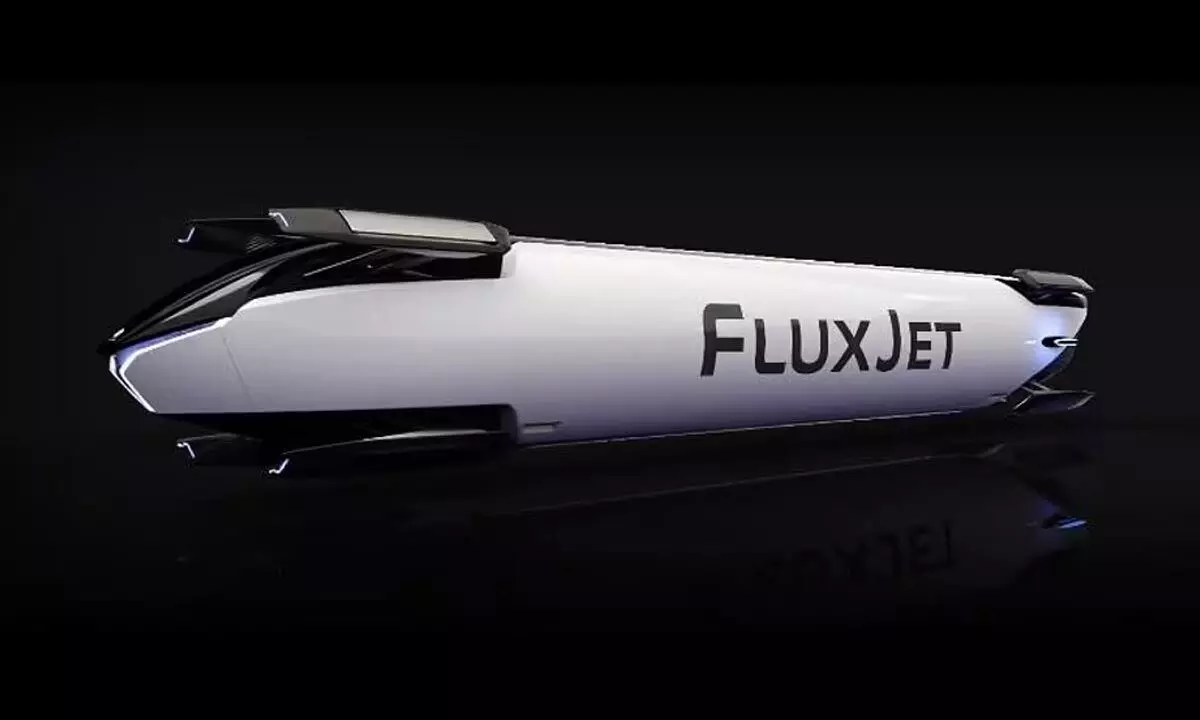Live
- Jyothika slams negative campaign on ‘Kanguva’
- It’s official: Naga Chaitanya and Sobhita Dhulipala to tie the knot in December
- ‘Kantara: Chapter 1’ locks release date for Oct 2025
- Telangana to Implement New EV Policy from Tomorrow, Aims for Cleaner Environment
- I was surprised with ‘Zebra’ script: Dolly Dhananjaya
- Aadi Saikumar’s ‘SI Yugandhar’ launches with grand pooja ceremony
- US confirms first case of clade I mpox in California
- Sandeep Reddy Vanga responds to 'female Arjun Reddy' question, teases woman-centric film
- Andhra Pradesh Government Simplifies Paddy Procurement with WhatsApp Services
- BJP to Hold Workshop, Plans Statewide Yatras and Rallies
Just In
All about the Canadian startup Hyperloop-style vacuum train 'FluxJet'


All about the Canadian startup Hyperloop-style vacuum train 'FluxJet'
The Hyperloop-style vacuum train 'FluxJet' is billed as a "wingless plane". The all-electric vehicle is a hybrid between a train and an aircraft and will travel at speeds of up to 620 mph (1,000 km/h).
A Canadian startup has unveiled a hyperloop-style vacuum train billed as a "wingless plane" that can carry passengers at 621 mph (1,000 km/h). The all-electric 'FluxJet' is a hybrid between a plane and a train and can carry up to 54 passengers and 10 tons of cargo. Its design is based on a new field of physics the company calls "surveillance flow" and features "contactless power transmission." TransPod, which is the firm behind the project, says the FluxJet will travel along its dedicated tube system across Canada known as the TransPod line. The vehicle is also equipped with aerodynamic and propulsion systems designed specifically to reduce friction.
This wingless plane can carry passengers at 621 mph (1,000 km/h)
The line will have stations in key locations and major cities, with modules expected to run every two minutes. TransPod, which recently received $550m (£468m) in funding, has already started preliminary construction on a tube that will transport people from Calgary to Edmonton in 45 minutes. It will remove nearly a third of traffic from the road between Calgary and Edmonton, TransPod says. Not only that, but travelling on the FluxJet will reportedly cost around 44 per cent less than a plane ticket and reduce CO2 emissions by approximately 636,000 tons per year. At the TransPod unveiling event in Toronto, a scaled-down prototype was unveiled in a live demo showcasing its flight capabilities. The nearly 1-tonne vacuum train performed takeoff, travel and landing procedures within its guide. Essentially, this design allows the magnetically levitated pods to travel at a faster speed than trains, cars and jets.
The FuxJet can reduce CO2 emissions by approximately 636,000 tons per year
'This milestone is a major leap forward,' says Ryan Janzen, co-founder and CTO at TransPod. 'The FluxJet is at a nexus of scientific research, industrial development, and massive infrastructure to address passengers' needs and reduce our dependence on fossil-fuel-heavy jets and highways.'
'All the hard work over the past few years has led to this milestone moment where talk is becoming a reality,' TransPod's co-founder and CEO Sebastien Gendron said. 'The technology is proven, and we have the confidence of investors, governments and partners to continue pushing forward to redefine transportation effectively.' Janzen added: 'The FluxJet is a first for Canadian innovation and is the next great infrastructure project to be brought worldwide.
The FluxJet is at a nexus of scientific research to address passengers' needs
'The TransPod Line is being developed in collaboration with our partners in Europe, USA, and beyond, including universities, research centres, the aerospace industry, architecture, railway, and construction partners.' It is a long tube that has had the air removed to create a vacuum. For safety reasons, Hyperloop tunnels need escape hatches in case of fire. The tube is suspended from the ground to protect it against weather and earthquakes.
The FluxJet is a first for Canadian innovation
Hyperloop is a proposed travel method that would transport people at approximately 700 mph between distant locations. The vision bears similarities to Virgin's Hyperloop network of 600mph pods set to be deployed by 2030, based on a system proposed by Elon Musk. It was introduced by Elon Musk in 2013, who at the time said it could get passengers 380 miles (610 km) from Los Angeles to San Francisco in 30 minutes, half the time it takes on a plane. There are now a number of companies competing to bring the technology to life, including Elon Musk himself, Hyperloop Transportation Technologies, and Virgin Hyperloop One.

© 2024 Hyderabad Media House Limited/The Hans India. All rights reserved. Powered by hocalwire.com






